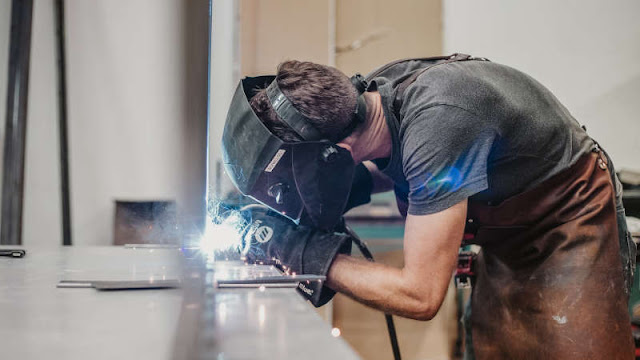The different types of welding
Welding is one of the best ways to join two (or more) parts together because it works at the atomic level: the two parts are thus joined to form one single part. Its main advantage is that it does not require any joining piece (such as a rivet, a staple or a bolt) because it merges the pieces together. Their assembly is therefore final.
Difference Between Welding and Brazing
Both welding and brazing are used to join parts together by fusing metals. But, the difference is in the assembled metals.
Indeed, welding makes it possible to assemble parts of identical metal (for example two steel parts) using a filler metal which will make it possible to connect these two parts. This filler metal must also be of the same material as the parts to be assembled. For effective welding, the ends of each part must first be fused before joining them using filler metal.
Conversely, brazing joins pieces of dissimilar metal using a filler metal in a material different from the two pieces. For example, a copper coin can be joined to a zinc coin using a tin backing metal. To obtain a quality solder, it suffices to melt the filler metal, no need for melting for the ends of the parts to be assembled.
The different welding techniques
There are different welding techniques that we will present to you in this guide.
1) Torch welding
Torch welding, or flame welding, is one of the best known and most widely used welding techniques. Its principle is simple: you have to obtain a flame using the torch and two types of gas. You need a fuel gas (such as acetylene, propane, butane or methane) and an oxidizing gas (mainly oxygen but sometimes hydrogen or natural gas).
The flame is most often obtained by a mixture of oxygen and acetylene (called oxy-acetylene) or by a mixture of oxygen and propane (called oxy-propane) because these mixtures give very high temperatures favorable to smelting of metals.
2) TIG welding
TIG (Tungsten Inert Gas) welding is a welding technique using an electric arc, a tungsten electrode and an inert (or neutral) gas. The electric arc is established between a tungsten electrode and the parts to be welded.
A neutral gas is projected into the welding zone to protect the electric arc, the electrode, the filler metal and the weld pool from air oxidation. This neutral gas is generally argon because it can protect all molten metals. This type of welding is intended for carrying out fine work requiring perfect welding quality.
3) MMA welding
MMA (Manual Metal Arc) welding is an electric arc welding technique. The aim is to create a short circuit which causes an electric arc and a very high heat release (4000 or even 4500°C). It is the electrode which serves as filler metal and which therefore makes it possible to carry out the weld by melting on the part to be welded. The electrode can be of three different types:
- It may be rutile, that is to say that the coating is made of titanium oxide, of ferrous alloy and of silicate;
- It can be basic with a coating of calcium carbonate, alloy and flux (sparfluor) allowing the melting temperature to be lowered;
- It can be cellulosic with a coating of cellulose and organic materials which ensures an abundance of gas and allows better penetration.
The electrode determines the choice of polarity: a rutile electrode has a direct polarity (electrode at -) while a basic electrode has an inverted polarity (electrode at +).
MMA welding is used for thick welds, wide beads and heavy mechanical stress.
4) MIG -MAG welding
MIG -MAG welding is a welding technique that creates an electric arc and combines two processes: the MIG (Metal Inert Gas) process which uses an inert shielding gas and the MAG (Metal Active Gas) process which uses a protective gas. active protection.
With this technique, the electrode serves as the filler metal. The inert gas (Argon or Helium) in the MIG process and the active gas (Argon/CO2 or Argon/Oxygen) in the MAG process protect the electrode, the electric arc and the weld pool. This welding technique is used for spot welds, thick or fast for the following materials: steel, stainless steel, aluminum.
5) Plasma welding
Plasma welding is a technique using an electric arc and which incorporates the processes of TIG welding and MIG welding. The plasma jet is obtained after creation of an electric arc between a non-fusible electrode and the part to be welded.
This technique needs an additional gas in addition to the main gas (usually Argon), called annular gas and which is composed of hydrogen or helium. The electrode is protected by a copper nozzle which is permanently cooled with water to prevent it from melting.

0 Response to "The different types of welding"
Post a Comment